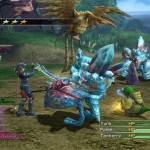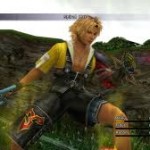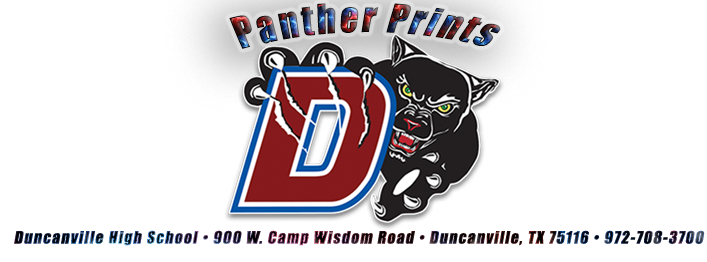
Back in 2011, Square Enix had announced an HD remaster of one of their biggest hit titles, Final Fantasy X, which came out for the PlayStation 2 way back in 2001. It was later revealed that this would actually be a compilation featuring both Final Fantasy X and its sequel, Final Fantasy X-2 (FFX and FFX-2 for short, respectively). For quite awhile, not much else was known about this remaster, but it garnered the attention of many fans nonetheless. Finally March of 2014 had arrived and the game was released in all regions with the international content of both games included, along with some other things which I’ll delve into soon. I will review both games along with the extra content that has been included in this re-release.
I’ll get these out of the way first: both games have had their graphics remastered and both games are, as the title suggests, in HD. The backgrounds, foregrounds, character models, and menu screens (in the case of X) have all gotten an upgrade. You may not notice much of a difference by just looking at screenshots, but once you’ve actually played the game you will realize there is definitely a noticeable improvement. The music has also been remastered for FFX (with no option to switch between the two soundtracks unfortunately); for whatever reason, X-2 was left alone in this regard. In case you’re unfamiliar with the games, I will explain the basics of each. Final Fantasy X starts out with our hero Tidus in the vast city of Zanarkand, located somewhere in the expansive seas of Spira. He is a professional Blitzball player, a sport that is played in a circular sphere of water with a ball . Soon after starting another one of his Blitzball matches, the city is attacked by a monstrous being called Sin. Not much is known about Sin other than the fact that it seemingly cannot ever be defeated for good. The people of Spira live their lives in constant fear of Sin. The only means known to defeat it is to become a summoner and go on a pilgrimage, together with the summoner’s protectors simply known as guardians. Guardians must embark on the journey with the summoner and protect him/her from harm at all times until his/her pilgrimage is completed. The method of defeating Sin once the pilgrimage is complete is revealed over the course of the story, so I won’t spoil it.
The gameplay is turn-based, with the turn order of your party members/characters being shown on the top-right corner of the screen while in a battle. You can manipulate the turn order by adjusting the speed of your characters and foes with different spells, as well as switching in different characters mid-battle. Unlike the Final Fantasy games before it, there is no traditional leveling in FFX. Instead, you increase your stats by activating nodes on a Sphere Grid. You move along this grid by gaining levels in the form of Sphere Levels; to gain levels, you must gain Ability Points (AP) by fighting monsters.
Aside from the gameplay, the story and music is where FFX really shines. The story is incredibly well-written and emotional and is a journey well worth experiencing. The music, although it has been modified, still retains its magic for the most part. If you’ve never played FFX before, you won’t care, but veterans will definitely take notice of it for better or for worse. In addition to the story, there is loads of side content to be experienced in FFX, especially towards the end of the game. There are several mini-games that unlock several things, as well as the Monster Arena which will be your primary source of stat-maxing for the superbosses. And of course there is Blitzball, which although I don’t like playing, many people find many hours of enjoyment out of.
Now let’s talk about Final Fantasy X-2. Some people love the game, some people merely like it, others hate it. Set two years after FFX, the game begins with a concert which introduces all three characters: Yuna, Rikku, and Paine of the Gullwings. The game is completely different in tone from the previous game, which turns many people away from it. Also, it is heavily sidequest-oriented, which may or may not be to your liking.

The gameplay, however, offers some of the series’ best, as even people who dislike the game generally agree on. This time it isn’t turn-based, and has gone back to the Active Time Battle (ATB) format of old in which every character has a bar that replenishes as time passes, and you preform moves when the bar is filled up. The enemies also have an ATB, although you cannot see it. The action in battles is very fast; as soon as your turn comes up, you can choose commands to fight with. You can also change the class of your character by switching Dresspheres, which are basically items that change your class. You gain Ability Points through battling, just as before, and rather than having anything like a Sphere Grid this time, you have traditional leveling experience again in which your level up through battling. You can either choose which ability to learn next or the game will do it for you, starting from the top to the bottom of the list of skills. Also, finally, for the first time outside of Japan, players are able to make use of the Creature Creator system. Basically, you are given four types of pods: S, M, L, and SP (Small/Medium/Large/Special), to plant on any area in Spira. Then you can round those pods up and see what monsters you have caught, if any. If a monster is caught, you can add it to your party at the cost of one (or in some cases, two, or even all, depending on the monster’s size) of your party slots.
As I mentioned earlier, FFX-2 is very sidequest-oriented, and it’s a lot more aloof than FFX. However, it is still a great game, especially with the addition of the Creature Creator, and if you can get through the slow first chapter, the game will pick up. It’s also designed around multiple playthroughs since there are a lot of things that are missable, and there certain “branches” that you can only do one or the other of in a single playthrough. Beating the game once unlocks New Game Plus, where you carry over your play time, percentage, Creature Creator stats, and pretty much everything else. The goal is to keep playing the game to experience new things and eventually reach 100%.
This should be obvious to anyone who’s played a PS3 game before, but there are also the addition of trophies in both games. And finally, not only can you play both games on one disc, but there is also the addition of an all-new audio drama, which is a 30-minute audio that opens up some new events that take place after X-2 and an extra Last Mission Special, which will possibly open the way for an FFX-3.
Overall, this is an excellent collection with two great games that could potentially last you months. Your mileage may vary on the remastered FFX soundtrack, but I thought it was good overall and definitely not worth skipping a purchase over. Bonus points for it making it portable through the Vita as well.
Pros and Cons:
+ Surprisingly decent remastered visuals and, in the case of FFX, soundtrack.
+ Two great games on one disc, with some neat little extras to go along with it.
+ Saves can be transferred from a PS3 to a Vita, and vice versa.
+ We finally get all the international content across both games that we’ve been missing for so long.
– Loading times can be rather poor on both games at times.
– There are a few instances of audio glitches, but they’re not too common and don’t seem to happen on the digital versions.
– Some of the remastered tracks in FFX are worse.
– The audio drama is unnecessary and feels like bad fan fiction.







